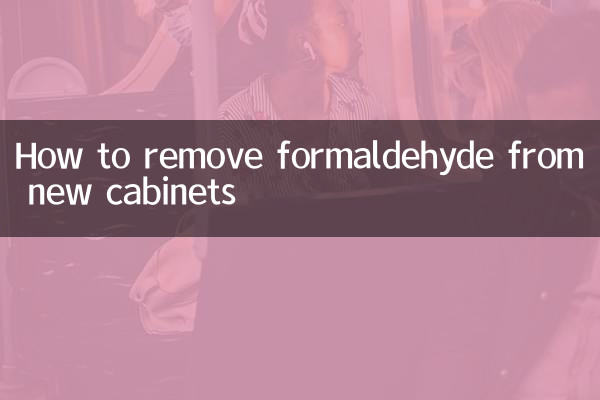How to remove formaldehyde from new cabinets
Newly bought cabinets often emit a pungent smell of formaldehyde, which not only affects the comfort of the home environment, but may also cause harm to health. Formaldehyde is a common indoor air pollutant, and long-term exposure can lead to respiratory diseases, skin allergies and even more serious health problems. Therefore, how to effectively remove formaldehyde from new cabinets has become the focus of many families. This article will combine popular topics and hot contents across the network for the past 10 days to provide you with a detailed guide to formaldehyde removal.
1. Source and harm of formaldehyde

Formaldehyde mainly comes from artificial boards, adhesives, paint and other decoration materials. The glue, coating and other materials used in the production process of the new cabinet will release formaldehyde, especially in high temperature and high humidity environments, the formaldehyde release rate will be accelerated. The following are the main harms of formaldehyde to the human body:
| Degree of hazard | Specific performance |
|---|---|
| Mild hazards | Discomfort in eyes and throat, headache, dizziness |
| Moderate hazard | Skin allergies, respiratory diseases, and decreased immunity |
| Severe hazard | Leukemia, cancer and other serious diseases |
2. Effective methods to remove formaldehyde
Regarding the formaldehyde problem in new cabinets, the following are some proven effective methods:
| method | Operation steps | Effect |
|---|---|---|
| Ventilation method | Place the cabinet in a well-ventilated place, open the cabinet door, and ventilate for at least 2 hours a day. | Remarkable effect, but it takes a long time |
| Activated carbon adsorption | Place activated carbon bags in the cabinet and replace them every 1 month | Good effect, suitable for long-term use |
| Plant absorption | Place green ivy, spider plants near the cabinet | Limited effect, suitable for auxiliary use |
| Air purifier | Use an air purifier with formaldehyde filtration | Significant effect, but high cost |
| Photocatalyst spray | Spray photocatalyst spray to decompose formaldehyde using ultraviolet rays | Good effect, but requires professional operation |
3. New ways to talk about hot topics
Recently, among the popular topics on formaldehyde removal across the entire network, the following methods have attracted much attention:
1. Nanomine crystal adsorption method
Nanomine crystal is a new type of formaldehyde adsorption material, whose adsorption capacity is more than 5 times that of activated carbon. Many netizens reported that after using nano-mineral crystals, the formaldehyde concentration in the cabinet dropped significantly.
2. High temperature fumigation method
Through the high-temperature steam fumigation cabinet, the release and decomposition of formaldehyde can be accelerated. This method has become a hot topic recently, but attention should be paid to controlling the temperature to avoid damaging the cabinet material.
3. Bioenzyme decomposition method
Bioenzymes can decompose formaldehyde molecules and convert them into harmless substances. This method is environmentally friendly and efficient, but is expensive and suitable for families who are sensitive to formaldehyde.
4. Things to note
During the removal of formaldehyde, the following points should be paid attention to:
1.Avoid over-reliance on a single approach: Combined with multiple methods, the effect is better.
2.Regularly detect formaldehyde concentration: Use a formaldehyde detector to ensure that the formaldehyde concentration is within a safe range.
3.Choose a regular product: When purchasing activated carbon, photocatalyst and other products, choose a formal brand to avoid secondary pollution of inferior products.
5. Summary
The formaldehyde problem in the new cabinet cannot be ignored. Through scientific methods and continuous efforts, the formaldehyde concentration can be effectively reduced and the health of the family can be protected. Among the various methods provided in this paper, ventilation method and activated carbon adsorption are the most economical and practical choices, while nanomines

check the details

check the details